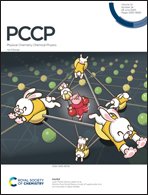Strain tuning of closed topological nodal lines and opposite pockets in quasi-two-dimensional α-phase FeSi2†
Abstract
Following topological nodal point semimetals, topological nodal line semimetals with one dimensional (1D) topological elements have recently aroused great interest worldwide in the fields of quantum chemistry and condensed matter physics. In this study, by means of first-principles, we predict that quasi-two-dimensional (2D) α-FeSi2 with a P4/mmm space group is a topological nodal line semimetal with two nodal lines close to the Fermi level, in the kz = 0 and kz = π planes. Usually, topological nodal line semimetals can be classified into type I, type II, and hybrid-type categories, each type with different physical properties. Importantly, for the first time, we find that type I, type II, and hybrid-type nodal lines can be realized in a realistic material, i.e., quasi-2D α-FeSi2, by strain switching. The realization of tunable nodal line types occurs because quasi-2D α-FeSi2 has special opposite-pocket-behaving bands around the Fermi level. The results presented herein reflect that α-FeSi2 is a valuable candidate for spintronics application by utilization of type I, type II, and hybrid-type topological nodal line semimetals in a single material tuned by mechanical strain.



 Please wait while we load your content...
Please wait while we load your content...